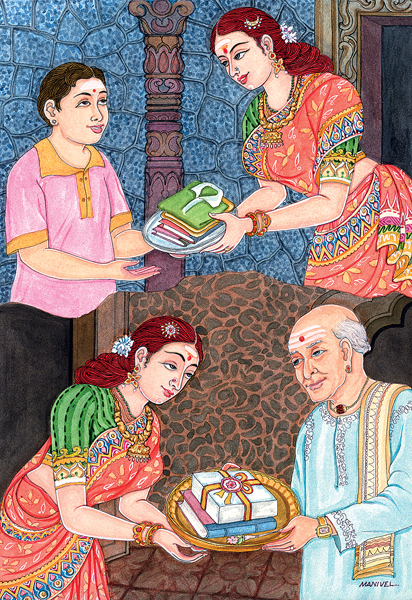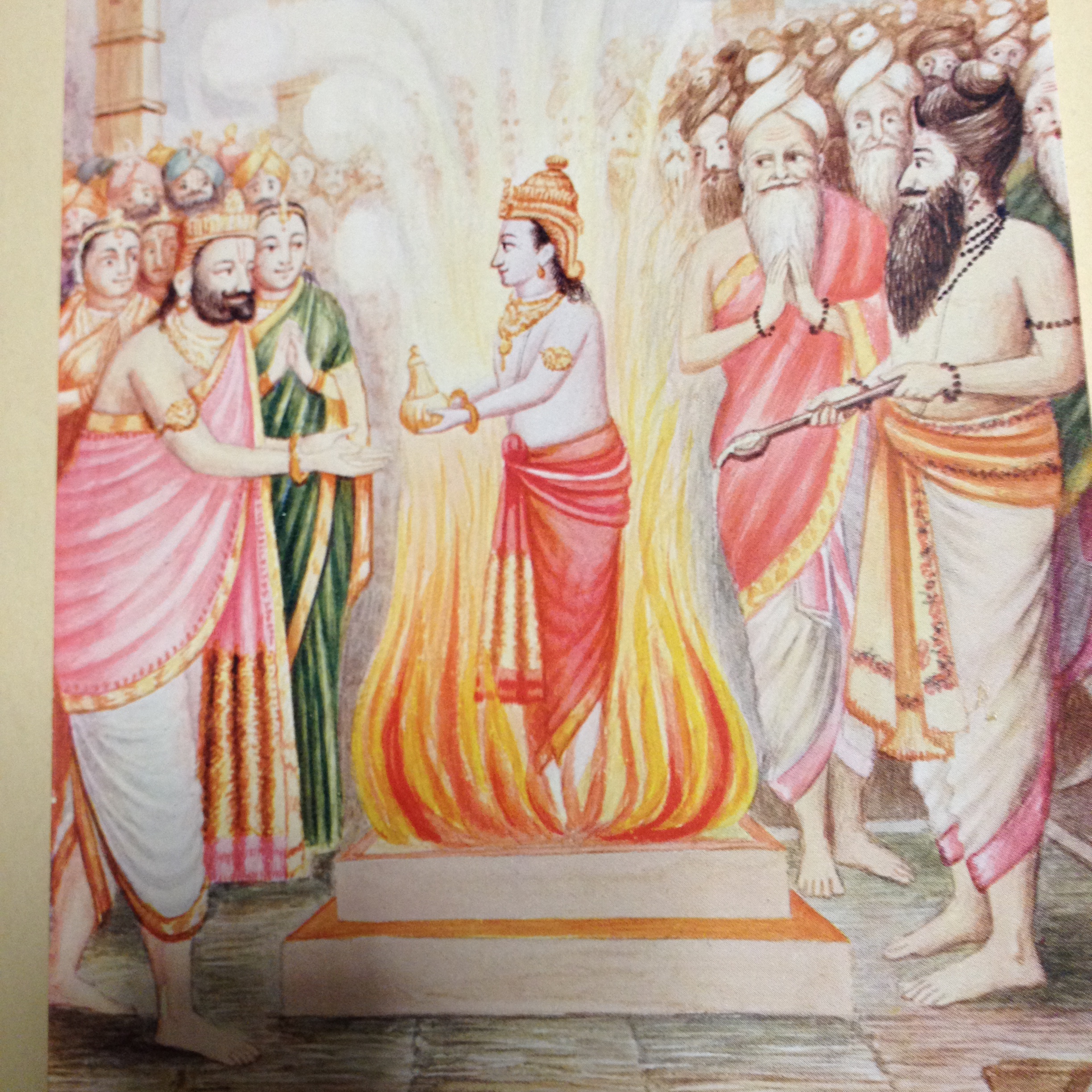|
Kamyakarma
Kamyakarma () refers to those ''karmas'' (deeds) in Hinduism that are prudential in nature, motivated by the desire for a given outcome. Unlike the '' nitya karmas'', the Shastras do not require daily or regular observance of these rituals. They are generally performed for the sake of their intended results. A few ''kamyakarmas'' are listed below: *''Putrakameshti'' *'' Agnistoma'' *''Agnicayana The Agnicayana ('; ) or Athirathram () is a category of advanced Śrauta rituals. After one has established the routine of the twice-daily routine of Agnihotra offerings and biweekly ''darśa-purna-masa'' offerings (Full and New Moon rites), ...'' See also *'' Nitya karma'' *'' Shrauta'' Yajna References Hindu philosophical concepts [...More Info...] [...Related Items...] OR: [Wikipedia] [Google] [Baidu] |
Nitya Karmas
Nityakarma () refers to obligatory Vedic duties that are prescribed for daily practice in Hinduism. Nityakarma is among the three ritual actions classified by the Mimamsa philosophy, along with nisiddhakarma and kamyakarma. It is also featured in the Shaiva Siddhanta philosophy. Description According to Parasara, the six activities are regarded to be nityakarmas: *Snana (bathing) *Sandhyavandanam (morning and evening prayers) *Recitation of the Vedas *Veneration of ancestors * Homam (offerings to fire) *Tarpana (worship of the gods) See also *Kamyakarma Kamyakarma () refers to those ''karmas'' (deeds) in Hinduism that are prudential in nature, motivated by the desire for a given outcome. Unlike the '' nitya karmas'', the Shastras do not require daily or regular observance of these rituals. They ... * Shrauta References Rituals in Hindu worship Hindu philosophical concepts {{Hindu-philo-stub ... [...More Info...] [...Related Items...] OR: [Wikipedia] [Google] [Baidu] |
Karma (Hinduism)
Karma is a concept of Hinduism which describes a system in which beneficial effects are derived from past beneficial actions and harmful effects from past harmful actions, creating a system of actions and reactions throughout a soul's ( jivatman's) reincarnated lives, forming a cycle of rebirth. The causality is said to apply not only to the material world but also to our thoughts, words, actions, and actions that others do under our instructions. Paramhans Swami Maheshwarananda, ''The hidden power in humans'', Ibera Verlag, page 23., For example, if one performs a good deed, something good will happen to them, and the same applies if one does a bad thing. In the Puranas, it is said that the lord of karma is represented by the planet Saturn, known as Shani. According to Vedanta thought, the most influential school of Hindu theology, the effects of karma are controlled by God (Isvara). There are four different types of karma: ''prarabdha'', ''sanchita'', and ''kriyamana'' and ... [...More Info...] [...Related Items...] OR: [Wikipedia] [Google] [Baidu] |
Hinduism
Hinduism () is an Hypernymy and hyponymy, umbrella term for a range of Indian religions, Indian List of religions and spiritual traditions#Indian religions, religious and spiritual traditions (Sampradaya, ''sampradaya''s) that are unified by adherence to the concept of ''dharma'', a Ṛta, cosmic order maintained by its followers through rituals and righteous living, as expounded in the Vedas. The word ''Hindu'' is an exonym, and while Hinduism has been called the oldest religion in the world, it has also been described by the modern term ''Sanātana Dharma'' () emphasizing its eternal nature. ''Vaidika Dharma'' () and ''Arya dharma'' are historical endonyms for Hinduism. Hinduism entails diverse systems of thought, marked by a range of shared Glossary of Hinduism terms, concepts that discuss God in Hinduism, theology, Hindu mythology, mythology, among other topics in Hindu texts, textual sources. Hindu texts have been classified into Śruti () and Smṛti (). The major Hin ... [...More Info...] [...Related Items...] OR: [Wikipedia] [Google] [Baidu] |
Shastra
''Śāstra'' ( ) is a Sanskrit word that means "precept, rules, manual, compendium, book or treatise" in a general sense.Monier Williams, Monier Williams' Sanskrit-English Dictionary, Oxford University Press, Article on 'zAstra'' The word is generally used as a suffix in the Indian literature context, for technical or specialized knowledge in a defined area of practice. ''Śāstra'' has a similar meaning to English ''-logy'', e.g. ecology, psychology, meaning scientific and basic knowledge on a particular subject. Examples in terms of modern neologisms include # 'physics', # 'chemistry', # 'biology', # 'architectural science', # 'science of mechanical arts and sculpture', # 'science of politics and economics', and # 'compendium of ethics or right policy'. In Western literature, ''Śāstra'' is sometimes spelled as Sastra, reflecting a misunderstanding of the IAST symbol 'ś', which corresponds to the English 'sh'. Etymology The word ''Śāstra'' literally means ... [...More Info...] [...Related Items...] OR: [Wikipedia] [Google] [Baidu] |
Putrakameshti
Putrakameshti () is a special yajna performed in Hinduism for the sake of bearing children. It is classified under a series of rituals called the kamya-karma. Literature In the ancient Indian epic Ramayana, upon the recommendation of Sage Vashishta, King Dasharatha of Ayodhya performed the Putrakameshti Yajna under the supervision of Rishyashringa, an expert in Yajurveda, which has the guidelines for this yajna. After its successful completion, the god of fire, Agni, appeared and gave a bowl of payasam to the King of Ayodhya, which was provided to his three queens in order to promulgate his sons Rama Rama (; , , ) is a major deity in Hinduism. He is worshipped as the seventh and one of the most popular avatars of Vishnu. In Rama-centric Hindu traditions, he is considered the Supreme Being. Also considered as the ideal man (''maryāda' ..., Lakshmana, Bharata, and Shatrughna. References External links ''Guide to Putrakameshti Homam'' Yajna {{Hi ... [...More Info...] [...Related Items...] OR: [Wikipedia] [Google] [Baidu] |
Agnistoma
In Hinduism, ''Yajna'' or ''Yagna'' (, ɐd͡ʒɲə ) also known as Hawan, is a ritual done in front of a sacred fire, often with mantras. Yajna has been a Vedic tradition, described in a layer of Vedic literature called Brahmanas, as well as Yajurveda. The tradition has evolved from offering oblations and libations into sacred fire to symbolic offerings in the presence of sacred fire (Agni). Yajna rituals-related texts have been called the ''Karma-kanda'' (ritual works) portion of the Vedic literature, in contrast to the ''Jnana-kanda'' (knowledge) portion found in the Vedic Upanishads. The proper completion of Yajna-like rituals was the focus of Mimansa school of Hindu philosophy. Yajna have continued to play a central role in a Hindu's rites of passage, such as weddings. Modern major Hindu temple ceremonies, Hindu community celebrations, or monastic initiations may also include Vedic Yajna rites, or alternatively be based on Agamic rituals. Etymology The word ''yajna'' ... [...More Info...] [...Related Items...] OR: [Wikipedia] [Google] [Baidu] |
Agnicayana
The Agnicayana ('; ) or Athirathram () is a category of advanced Śrauta rituals. After one has established the routine of the twice-daily routine of Agnihotra offerings and biweekly ''darśa-purna-masa'' offerings (Full and New Moon rites), one is eligible to perform the Agnistoma, the simplest soma (drink), soma rite. After the agnistoma, one is eligible to perform more extensive soma rites and Agnicayana rites. There are various varieties of Agnicayana. Agnicayana continues to be performed in Kerala. Overview The entire ritual takes twelve days to perform, in the course of which a great bird-shaped altar, the ''uttaravedi'' "northern altar" is built out of 1005 bricks. The liturgical text is in Chapters 20 through 25 of the ''Yajurveda, Krishna Yajurveda''. The immediate purpose of the Agnicayana is to build up for the sacrificer an immortal body that is permanently beyond the reach of the transitory nature of life, suffering and death that, according to this rite, char ... [...More Info...] [...Related Items...] OR: [Wikipedia] [Google] [Baidu] |
Yajna
In Hinduism, ''Yajna'' or ''Yagna'' (, Help:IPA/Sanskrit, [jɐd͡ʒɲə], ) also known as Hawan, is a ritual done in front of a sacred fire, often with mantras. Yajna has been a Vedas, Vedic tradition, described in a layer of Vedic literature called Brahmanas, as well as Yajurveda. The tradition has evolved from offering oblations and libations into sacred fire to symbolic offerings in the presence of sacred fire (Agni). Yajna rituals-related texts have been called the ''Karma-kanda'' (ritual works) portion of the Vedic literature, in contrast to the ''Jnana-kanda'' (knowledge) portion found in the Vedic Upanishads. The proper completion of Yajna-like rituals was the focus of Mimansa school of Hindu philosophy. Yajna have continued to play a central role in a Hindu's rites of passage, such as weddings. Modern major Hindu temple ceremonies, Hindu community celebrations, or monastic initiations may also include Vedic Yajna rites, or alternatively be based on Āgama (Hinduism), A ... [...More Info...] [...Related Items...] OR: [Wikipedia] [Google] [Baidu] |



